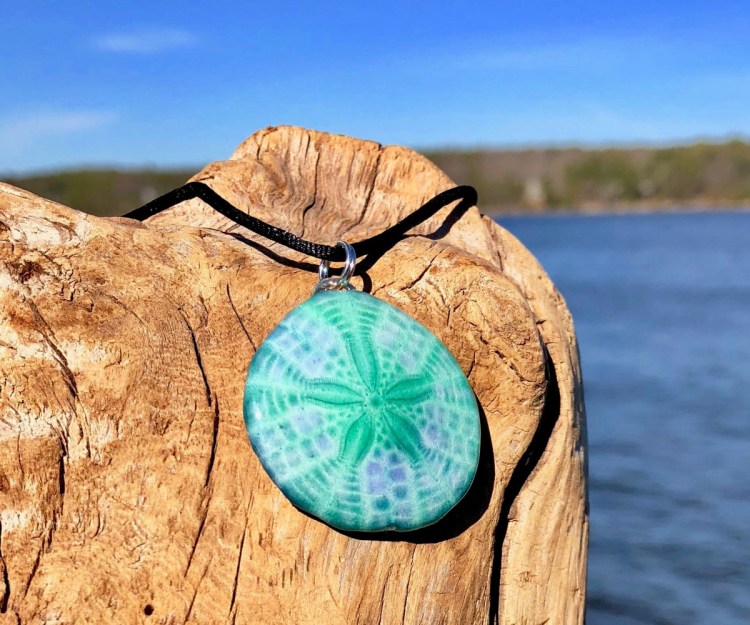One cold December night about 14 years ago, Sarah Kulis was sitting by the fire with her husband, Doug, painting peoples’ names on sand dollars so the little treasures from the sea could be used as gift tags or Christmas ornaments. In what Kulis now considers a really happy accident, they spilled red wine on a pile of sand dollars. Thinking the sand dollars were ruined, the couple left them by the wood stove to dry and went to bed.
“And when we came down the next morning,” Kulis said, “everything about them was beautiful.”
The wine had seeped into the porous sand dollars, turning them a warm color and creating interesting patterns. That gave Kulis an idea. She started experimenting with colored dyes and protective sealants, learned how to turn the dyed pieces into necklaces, and a business was born: Sarah’s Sand Dollars. Nearly all of the sand dollars Kulis uses to make her jewelry come from her own lobster traps. The rest come from fellow fishermen who save them for her.
Kulis learned how to fish for lobster from her father – she still lives just 5 miles from where she grew up – and she carries on the family lobstering tradition at their home in Georgetown. (Her 16-year-old daughter, Dory, has just joined her mother on the family lobster boat.) The sand dollars that get caught in Kulis’ traps vary in size from about a half-inch to 2 inches in diameter. She dyes them blue, pink, green, brown or purple. Getting the colors right was one of her biggest challenges. In the beginning, when Kulis was trying out different dyes, some would change color or fade as the sand dollar dried. One homemade dye she tried turned them all yellow. Now she’s got her technique down, but still doesn’t have complete control over what color the sand dollars will be, or what patterns might show up – sometimes the star in the center is more prominent, sometimes it’s the little dots around the edges.
“I can dip 10 sand dollars in the same dye, and they all come out different,” Kulis said.
Over the winter, Kulis’ 15-year-old daughter, Brooke, developed a two-toned sand dollar by painting one side of the sand dollar with one color, and the other side with a different color. Each color bled on through to the other side, to paraphrase The Doors, resulting in a tie-dye effect.
The necklaces range from $28 to $32, depending on where they are sold. Kulis sells to about two dozen stores, mostly along the coast, including Boothbay Harbor Artisans; Lisa-Marie’s Made in Maine and the Maine Medical Center gift shop in Portland; the Mid Coast Hospital gift shop in Brunswick; The Knotty Sailor in Ogunquit; the Samoset Resort gift shop in Rockport; and all three Georgetown Pottery locations. Kulis also takes orders via Facebook or email (sarahssanddollars@myfairpoint.net).
Kulis sells at craft fairs as well, except during summer, when lobstering takes up more of her time. She says everyone she meets at the fairs seems to have a happy memory of finding sand dollars on a family vacation at the beach.
— MEREDITH GOAD
Send questions/comments to the editors.



Success. Please wait for the page to reload. If the page does not reload within 5 seconds, please refresh the page.
Enter your email and password to access comments.
Hi, to comment on stories you must . This profile is in addition to your subscription and website login.
Already have a commenting profile? .
Invalid username/password.
Please check your email to confirm and complete your registration.
Only subscribers are eligible to post comments. Please subscribe or login first for digital access. Here’s why.
Use the form below to reset your password. When you've submitted your account email, we will send an email with a reset code.